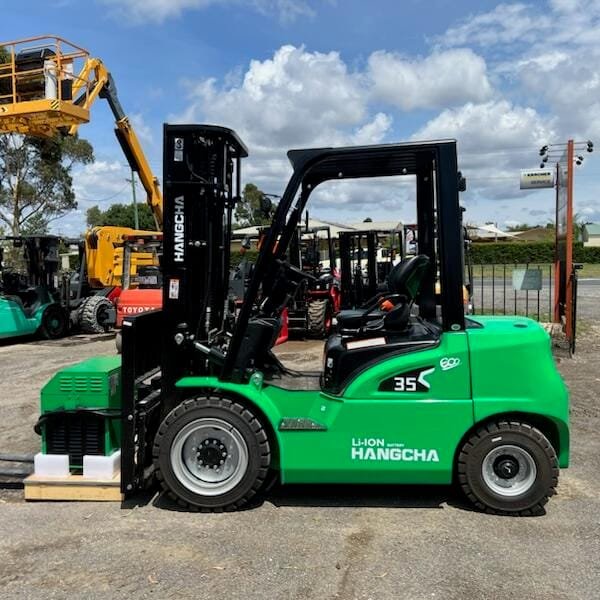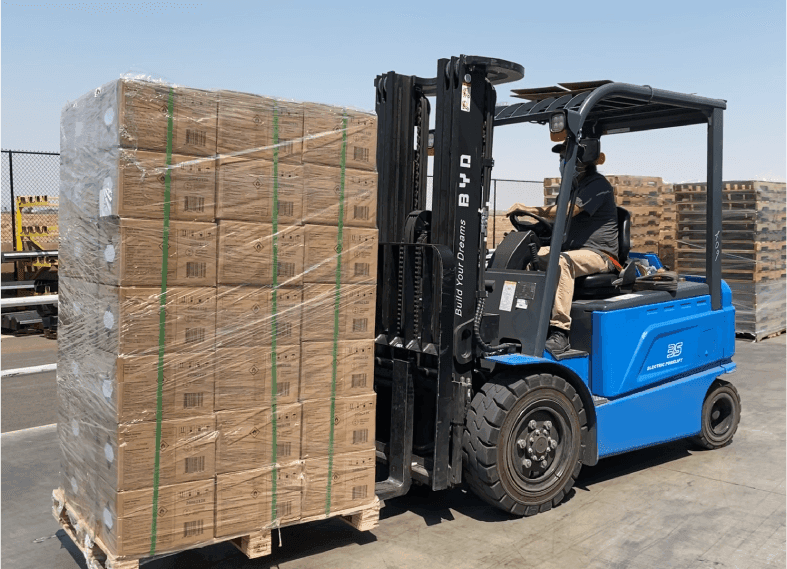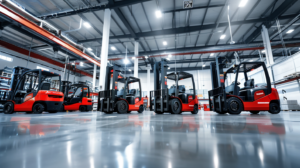Electric forklifts have become the preferred choice for businesses worldwide, particularly due to their environmental benefits, low operating costs, and efficiency in indoor environments. These forklifts offer a cleaner, quieter, and more cost-effective solution compared to their internal combustion counterparts. But with so many options available, how do you judge which electric forklift is the best for your needs?
This article will walk you through key factors to consider when choosing an electric forklift. You’ll learn how to assess forklift quality, the features to look for, and the various types of electric forklifts available in the market. By the end of this article, you’ll have the tools to determine which electric forklift fits your specific business requirements.

Understanding the Types of Electric Forklifts
Before we dive into the factors that make an electric forklift stand out, it’s important to understand the different types of electric forklifts available. Each type is designed for specific tasks and environments. Here are the main categories:
1. Electric Counterbalance Forklifts
These are the most common type of electric forklifts and are ideal for lifting and transporting loads in warehouses, manufacturing facilities, and distribution centers. Electric counterbalance forklifts are versatile, with a design that allows the operator to lift loads from the front, making them ideal for narrow aisles and confined spaces.
Pros:
- Highly maneuverable
- Can handle a wide range of loads
- Versatile for both indoor and outdoor use (with certain models)
Cons:
- Typically, lower lift heights compared to other types
- May have less stability for very heavy loads
2. Electric Reach Forklifts
These forklifts are designed for narrow aisles and high-lift operations. The reach forklift has a telescoping mast that allows the operator to extend the fork arms forward and upward, making it ideal for racking systems in warehouses that require high lift heights.
Pros:
- Excellent for high-lift tasks
- Ideal for tight spaces and narrow aisles
- Great for environments where vertical lifting is required
Cons:
- Limited outdoor use
- More complex to operate

3. Electric Pallet Jacks (Electric Pallet Trucks)
Electric pallet jacks are compact, cost-effective machines designed for moving palletized loads over short distances. They are commonly used in warehouses, distribution centers, and retail stores for quick and easy movement of goods.
Pros:
- Ideal for short-distance tasks
- Low cost compared to other forklift types
- Easy to maneuver
Cons:
- Not suitable for heavy lifting or long-distance transport
- Limited lift height
4. Electric Order Pickers
Order pickers are designed for picking individual items from high racking systems. These forklifts have a platform that elevates the operator, allowing them to retrieve items from elevated shelves with ease.
Pros:
- Designed for high-reach picking tasks
- Increases operator safety by allowing workers to access high racks
- Ideal for warehouses with high shelving systems
Cons:
- Not designed for heavy lifting
- Slower than other types of forklifts for moving large loads
5. Electric Stackers
Electric stackers are used for stacking and retrieving goods, typically in narrow aisles. These forklifts are designed for light-to-medium duty lifting and are perfect for warehouses with limited space.
Pros:
- Ideal for high stacking in tight spaces
- Lower cost compared to other forklift types
- Easy to operate
Cons:
- Not suitable for heavy lifting
- Limited outdoor use

Key Factors to Consider When Choosing an Electric Forklift
Choosing the best electric forklift for your business involves understanding your specific needs and considering several factors that can affect the forklift’s performance and durability. Here’s a breakdown of the key factors to consider when evaluating electric forklifts.
1. Lift Capacity
One of the most important factors to consider when choosing an electric forklift is its lift capacity. This refers to the maximum weight the forklift can safely lift. If your warehouse or facility handles heavy loads, you’ll need a forklift with a higher lift capacity. However, if your operation involves lighter loads, a smaller forklift may be more cost-effective.
- Light-duty forklifts: Ideal for loads under 2,000 lbs
- Medium-duty forklifts: Suitable for loads between 2,000 lbs and 4,000 lbs
- Heavy-duty forklifts: Required for lifting loads above 4,000 lbs
2. Battery Type and Runtime
Electric forklifts are powered by batteries, and the type of battery and its runtime will significantly impact the forklift’s performance. Most modern electric forklifts use lithium-ion or lead-acid batteries. Here’s a comparison of both:
- Lithium-ion batteries: Offer longer runtimes, faster charging times, and longer lifespans. They are ideal for operations that require the forklift to work continuously throughout the day with minimal downtime.
- Lead-acid batteries: Typically cost less upfront but have shorter lifespans and longer charging times. They are suitable for businesses that can manage longer charging times or that don’t require continuous operation.
When evaluating battery performance, you should also consider:
- Battery life cycle: How many charge cycles the battery can handle before it needs replacement.
- Charging time: How long it takes to charge the battery fully.
- Battery capacity: The amount of energy the battery can store, which impacts runtime between charges.
3. Maneuverability and Size
The size of the forklift is crucial depending on the environment in which it will be used. If you have a small warehouse or narrow aisles, a compact and highly maneuverable forklift is essential. Electric forklifts, especially those with small turning radii, are excellent for tight spaces. Counterbalance forklifts, for instance, provide good maneuverability, while reach trucks are designed for narrow aisles but may require more space to operate efficiently.

4. Forklift Height and Reach
Another key factor is the forklift’s lift height. If your business involves stacking goods at high shelves, you’ll need a forklift with a high lift capacity and reach. Reach forklifts, as the name suggests, are designed specifically for high-reach operations. They are equipped with telescoping masts, allowing them to extend far beyond what other forklifts can manage. If your operation involves extensive vertical lifting, this will be an important consideration.
5. Cost of Ownership
While electric forklifts tend to have a higher upfront cost than internal combustion forklifts, they often result in lower operating costs. Factors contributing to the cost of ownership include:
- Energy consumption: Electric forklifts typically have lower operating costs in terms of fuel (electricity vs. fuel) compared to their gas or diesel counterparts.
- Maintenance costs: Electric forklifts generally have fewer moving parts than combustion models, meaning less maintenance. For instance, there is no need for oil changes, reducing service costs.
- Battery replacement: While lithium-ion batteries last longer and charge faster, they are more expensive to replace than lead-acid batteries.
6. Operator Comfort and Safety
A forklift that is uncomfortable or difficult to operate can lead to reduced productivity and increased risk of accidents. When evaluating an electric forklift, ensure it is ergonomically designed for operator comfort. Key features to consider include:
- Adjustable seats and steering columns
- Low vibration levels
- Clear visibility from the operator’s cabin
- Safety features such as load sensors, alarms, and stability control
7. Durability and Build Quality
You want a forklift that is durable and built to last. Check the materials used in the forklift’s construction. High-quality steel and reinforced components will ensure the forklift can withstand the rigors of daily operation, especially in rough environments. It’s also a good idea to look for forklifts from reputable manufacturers that offer solid warranties and have a good track record for product durability.

Popular Electric Forklift Brands to Consider
Here are some well-known manufacturers of electric forklifts, each offering a range of models that vary in size, power, and specialized features.
1. Toyota Material Handling
Toyota is a leader in the forklift industry, offering a wide range of electric forklifts suitable for various applications. Toyota’s electric forklifts are known for their durability, efficiency, and advanced technology. Their models include both 3-wheel and 4-wheel electric counterbalance forklifts, as well as reach trucks and pallet jacks.
2. Linde Material Handling
Linde is another top manufacturer with a strong reputation for producing high-quality electric forklifts. Linde’s electric forklifts are renowned for their maneuverability and energy efficiency. They offer a variety of models, including compact forklifts and heavier-duty options.
3. Jungheinrich
Jungheinrich is known for producing high-performance electric forklifts, particularly for warehouses that require high lift capacities. Their electric forklifts are designed with advanced safety features and ergonomic designs, making them a popular choice for businesses that prioritize operator comfort and safety.
4. Hyster-Yale
Hyster-Yale offers a broad selection of electric forklifts designed for light to heavy-duty operations. Their models are known for their long battery life, easy-to-use features, and superior performance in tough conditions.
5. Clark Material Handling
Clark is known for its reliability and affordability, offering a variety of electric forklifts for different industries. They specialize in providing solutions for tight spaces and are recognized for their commitment to low maintenance and cost-effective operations.

Conclusion
When choosing the best electric forklift for your business, consider key factors such as lift capacity, battery type, maneuverability, and safety features. Each business has unique needs, so it’s essential to evaluate your specific requirements before making a decision. By doing so, you can ensure that your investment will not only increase productivity but also reduce operating costs and improve overall efficiency.
As you evaluate different models and brands, remember that the best electric forklift is one that balances performance, cost, and reliability to meet the demands of your specific operation. If you need further assistance in selecting the right forklift, feel free to reach out to Nicosail for expert guidance and to explore a range of high-quality electric forklifts designed to meet the needs of various industries.




